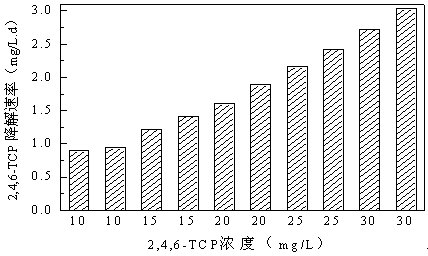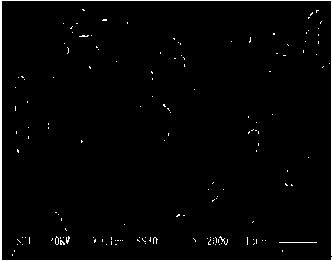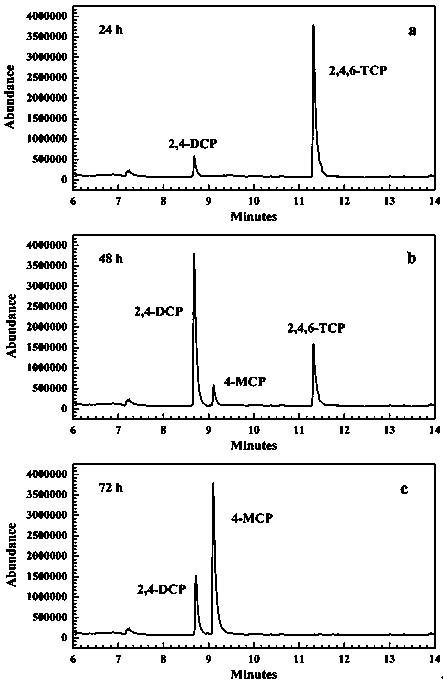Efficient 2, 4, 6-trichlorophenol degrading bacterial strain and separation method thereof
A technology of trichlorophenol and 3gkh2po4, applied in the direction of using microorganisms, methods based on microorganisms, biochemical equipment and methods, etc.
- Summary
- Abstract
- Description
- Claims
- Application Information
AI Technical Summary
Problems solved by technology
Method used
Image
Examples
Embodiment 1
[0009] Embodiment 1: Domestication, separation and screening of chlorophenol-degrading bacteria in the present invention
[0010] Collect the activated sludge from the anaerobic treatment reactor in the wastewater internal circulation of a paper mill in Hunan, measure 1 L of the semi-fluid sludge and add it to the domestication culture bottle, then add 1 L of the domestication medium to adjust the pH to between 6.0-8.0 between. Fill the acclimatization culture bottle with nitrogen gas, and seal it with a rubber stopper with an air guide tube. One end of the air guide tube is inserted below the liquid level in the bottle, and the outer end of the bottle is inserted into the sodium hydroxide solution for liquid sealing. Put the whole set of acclimatization device in an anaerobic biochemical incubator for acclimation culture at 30-40°C. During the acclimatization process, regular samples were taken to measure the residual concentration of 2,4,6-TCP in the acclimatized sample, an...
Embodiment 2
[0011] Embodiment 2: the biological identification of bacterial strain in the present invention
[0012] 1. Morphological characteristics
[0013] (1) Morphological characteristics of colonies: white, opaque, with neat edges, round, smooth and slightly raised. (2) Morphological characteristics of bacterial cells: the bacterium is Gram-negative, short rod-shaped, 0.5-0.7 μm×1.0-2.0 μm in size, without flagella, see attached figure 2 ;
[0014] 2. Physiological and biochemical properties: able to hydrolyze glucose, sucrose and fructose, produce indole and hydrogen sulfide, liquefy gelatin and form biofilm, and test positive for catalase, lecithinase and esterase; but cannot hydrolyze Starch, V-P, methyl red, nitrate reduction, and denitrification tests were all negative. The suitable growth temperature is 30~40 ℃, and the pH is 6.0~8.0;
[0015] 3. 16S rDNA molecular identification and phylogenetic analysis
[0016] Bacterial Genomic DNA Extraction Kit was used to extract ...
Embodiment 3
[0017] Example 3: Degradation effect of strains of the present invention on 2,4,6-TCP
[0018] Inoculate the purified TB-1 strain into the acclimatization medium, and culture it statically in an anaerobic incubator at 35 °C for 2-3 days, and inoculate the culture solution to the 2,4,6-TCP concentrations were 30, 60, 90, 120, 150 mg / L dechlorinated degradation medium. Fill the culture flask with nitrogen, and culture it statically in an anaerobic incubator at 35 °C. Samples were taken every 12 hours to determine the content of 2,4,6-TCP in the sample. The results are shown in the appendix Figure 4 . And use gas chromatography-mass spectrometry to detect the intermediate products produced in the degradation process, the results are shown in the attached Figure 5 . Figure 4 The results showed that TB-1 could completely degrade 2,4,6-TCP at a concentration of 30 mg / L within 72 hours, and partially degrade it at a concentration of 150 mg / L of 2,4,6-TCP. Figure 5 The results...
PUM
 Login to View More
Login to View More Abstract
Description
Claims
Application Information
 Login to View More
Login to View More - R&D
- Intellectual Property
- Life Sciences
- Materials
- Tech Scout
- Unparalleled Data Quality
- Higher Quality Content
- 60% Fewer Hallucinations
Browse by: Latest US Patents, China's latest patents, Technical Efficacy Thesaurus, Application Domain, Technology Topic, Popular Technical Reports.
© 2025 PatSnap. All rights reserved.Legal|Privacy policy|Modern Slavery Act Transparency Statement|Sitemap|About US| Contact US: help@patsnap.com



